Chord Substitution
How To Substitute Chords For Better Songs
In this tutorial, we're going to learn the most common types of chord substitution .
The art of replacing chords is useful for songwriting and for transforming any boring song into an original and creative one.
This is a bit advanced topic aimed at intermediate guitar players who already know their chords , but don't worry, we'll try to make things easy (if you need a complete resource to learn all about chords, get our chords ebook now).
Before reading the tutorial, be sure to be familiar with the Nashville Numbers and Roman Numerals systems : these notations will be used throughout this tutorial.
Are you ready? Let's begin!
Chord Substitution Chart
| Substitution | Example | Explanation |
|---|---|---|
| Major/Minor to Suspended | C to C sus2, C sus4 | Learn more |
| Adding the 9th | C to C9 | Learn more |
| I Maj7 to iii minor | C maj7 to E min | Learn more |
| I6 to vi m7 | C6 to Am7 | Learn more |
| Major and Minor swap | C to Cm | Learn more |
| I to vi m | C to Am | Learn more |
| Secondary Dominant | C | G7 to C | D7 | G7 | Learn more |
| Degrees Substitution | C to Em, F to Dm, G to Bdim | Learn more |
| bVII borrowed chord | C | G | Am | F to C | G | Bb | F | Learn more |
| V7 to vii dim7 | G7 to B dim7 | Learn more |
| VI to #i dim | A7 to C#dim | Learn more |
| V to Vdim | G to G dim | Learn more |
| Tritone Substitution | G7 to Db7 | Learn more |
All popular music is guided by a set of rules. Even if you are a new guitar player sitting down to write your first song , you will unwittingly follow the rules.
If you don't your song will likely sound bad!
However, the rules are there to be broken and there are specific ways to break them.
By taking common progressions and using chord substitution you can come up with new melodies, riffs, and songs.
Chord Progression Review
Before we can start substituting chords we need to know the most popular chord progressions .
Generally most songs use one of these at some point, sometimes if they make enough changes you won't even notice.
Changes can be: Modulations (key changes) , Extended chords , and Chord substitution
And the names of the progressions or genres below are really just estimates of popularity, they can mostly be used by any musician and style
| Progression | Degrees |
|---|---|
| Pop/Rock | I-IV-V |
| Pop Rock Lydian | I-II-IV-I |
| Folk/Pop | I-V and I-IV |
| "Axis of Awesome" | I-V-vi-IV |
| Doo Wop | I-vi-IV-V |
| Sensitive | vi-IV-I-V |
| Blues | I-IV-I-V-I (or similar variation) |
| Jazz | ii-V-I |
| Classic Rock | I-bVII-IV (also bIV mixes well in variations) |
| Classic Rock Ballad | I-iii-IV-V |
| Augmented Ascending | I-Iaug-I6-I7 |
| Medieval/La folia | i-V7-i-VII-III-VII-i-V7-i |
| Old Pop Standard | I-I#dim7-ii7-V |
| Jazz Standard | I-vi-ii-V |
The progressions are denoted with the Roman Numerals System : the uppercase Roman Numeral is major and the lowercase a minor, and these can all be played in different keys.
In some cases when analyzing a song you can simplify the chords so it is easier to spot the progression:
You will still use those notes when substituting it just helps when first outlining a song.
Now that you know most progressions here are some ways to go about finding new chord ideas.
Different Types of Substitution
There are a number of different methods of substitution and chord transformation, , some are pretty simple and barely meet the definition.
For example extending a chord isn't the same substitution as changing its key, but you are still changing the qualities of the chord.
So we will include every common method used.
And you will see some overlap, as always in music theory you can have multiple ways of finding an answer.
The point is to not overthink the process .
Look at the chords you are given and make your best judgment on what to replace them with.
And even if you are following the guidelines below always use your ear .
Note : most of the examples below are in the key of C .
Of course you can substitute any chord by applying the generalized formula (see the table at the top).
Replacing a major or minor chord with its sus2 or sus4 version (C to C sus2 or C sus4)
For example, substitute a C major with a C sus2 or C sus4
C Major

C sus2
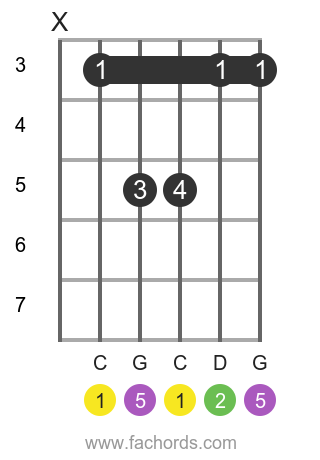
C sus4

When we remove the 3rd note and add the 2nd or 4th we get a suspended chord .
Using a Csus2 (C D G) would give us a different sound than C major.
In a lot of rock music progressions the sus2 and sus4 are commonly seen.
In " Free Fallin " Tom Petty adds both to his intro on a basic I-IV-V progression .
The sus chords are big in folk and rock.
Adding the 9th to a chord (C to C9)
We can add the 9th to a chord to make it sound more interesting.
C Major

C add9
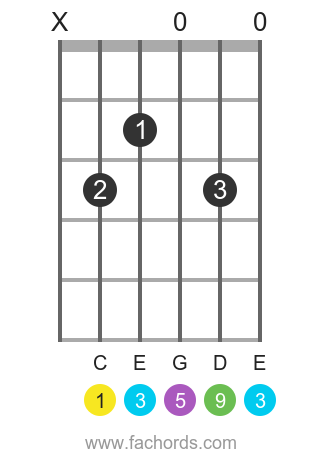
Take the C major; we can add the D as the 9th and have C9 (C E G Bb D).
The 9th is common in funk, boogie woogie, and R&B in general (especially when it is a 9sus4).
Substituting the I Maj7 with iii minor (C maj7 to E min)
Once you are comfortable with extended chords start cutting parts off to substitute.
Take the chord Cmaj7 .
C maj7
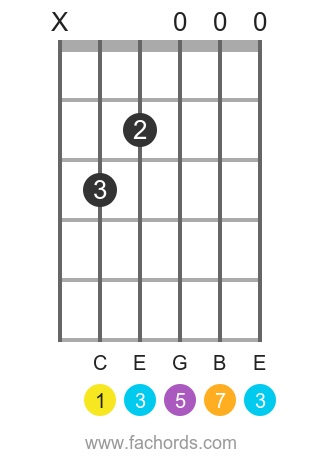
E min
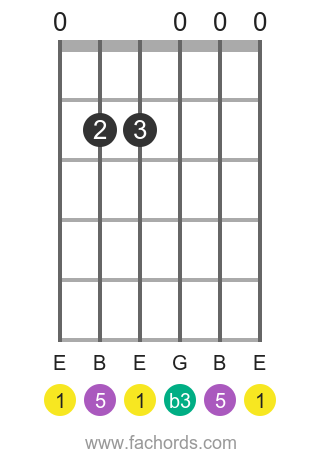
It is made up of C E G B .
Now just chop that root note off (C) and use E G B , the notes that compose the Em.
And of course Em is the mediant (iii) of the key of C.
And as you will see this is used in similar methods below.
By cleverly cutting off certain parts of our chords we can find a quick way to substitute.
Substituting the I6 with vi m7 (C6 to Am7)
We can use chord inversions to figure out new substitution ways.
C6
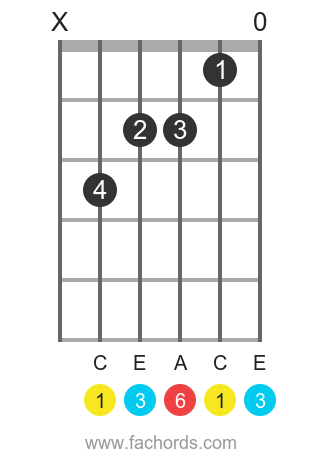
Am7
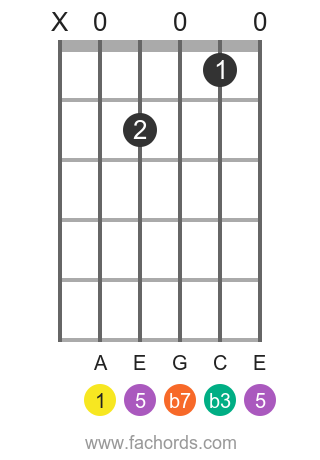
Remember inversions are where we would play a C major C-E-G like G-C-E to get the same chord, but a little different sound.
Technically first and second inversions involve the triad notes starting on a different root , but inversion will also apply to all note order changes.
When we have four notes like a C6 C-E-G-A (a sixth chord ) it can also be an Am7 A-C-E-G .
This reordering of notes is a great way to find a new direction to go in a song.
And it can also be used to make transitions with a bass line , a very common part of pop and rock.
Example Songs
At the first verse of " I Am the Walrus " the chords go A to A/G to C to D/E and back to A again.
They transition from A to C using G in the bass and D back to A using E in the bass.
" Landslide " is another popular tune that substitutes a first inversion and a couple slash chords with different bass notes.
Switching Major and Minor
One of the easiest ways to substitute is to simply change a major chord to a minor or the opposite way.
C Major

C m
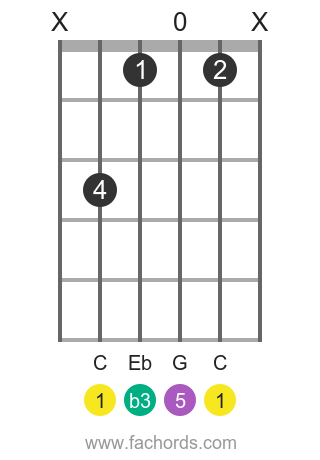
This is quick and requires no music theory skills at all.
Example Songs
- In " Eight Days a Week " The Beatles use an E (II) instead of Em (ii)
- Hank Williams also makes the same minor to major change in " Hey Good Lookin. "
- The Beatles also took that common V and made it a minor v for the bridge of " I Want to Hold Your Hand " The song uses the key of G and its fifth D, and then changes to Dm , it makes for a great mood change in the song.
And of course, there are famous songs that switch majors to minors . For example:
- " Air That I Breathe " and " Creep " do this. And if you notice they are the same song!
- So is Lana Del Rey's " Get Free ". People reuse progressions unknowingly all the time.
The famous jazz substitution/progression ii-V7 can also be changed from minor to major making it II7-V7 .
You may also see these switches for fun, sometimes folks purposely take a song and switch the minor and major to get something really weird.
Substituting the I with the relative minor vi m (C to Am)
This requires our Circle of Fifths chart or you can remember the vi to every root I.
Pro tip: on the fretboard, if you place your root on the E low string , the 6th is always two strings up and one fret down .
C Major

A minor

This is a very simple method like the one before, just in this case the root changes also.
Example songs
You will see it often in rock songs that switch from the major to the relative minor like:
- "Mr. Jones"
- "Into the Great Wide Open"
- "Crazy Train"
Replacing the I with the Secondary relative minor
We can also substitute the secondary relative minor .
We find the dominant of the key (V) we are in and then use that key's relative minor.
Example: in the key of C, the dominant is G, and the relative minor of the key of G is E, so we can substitute C major with E minor .
C Major

E minor

Another example: to substitute F maj , we know that it's dominant is C (one fifth up from the root F), and the relative minor of C is Am .
F Major
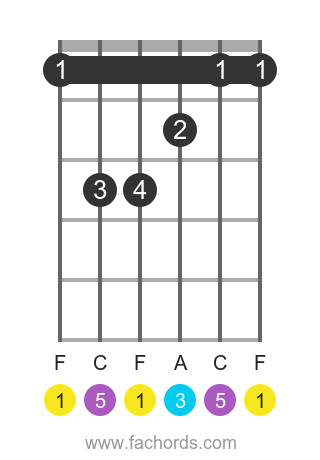
A minor

This is easy to find on the Circle of Fifths as the minor of the next chord in clockwise direction :

Adding Secondary Dominant to Make Progressions More Interesting
Sometimes we don't use the relative minor, just the secondary dominant .
In the key of C the root or tonic is C major and the dominant or fifth is G major .
To find the secondary dominant we go to the fifth of G which is D7 .
We can use this method of the " dominant of the dominant " which is the same as following the Circle of Fifths. Giving us one of the main patterns of many jazz songs .
As you've seen that pattern can be manipulated in a variety of ways.
Here's a simple example in the key of C.
We simply add the dominant (D7) of the dominant (G7) of our key (C):
C | G7 becomes C | D7 | G7
We can get creative and place a secondary dominant before any chord (called in this context target chord ). This technique is used to create tension and anticipation before our target chord, as the dominant pleads to be followed by its tonic.
Sometimes this substitution works greatly, others less.
Let your ear decide.
For example, if we want to create more tension before the Am chord in the following progression, we substitute the chord that precedes our target chord Am with its dominant (E7):
C | Em | Am becomes C | E7 | Am
Example song
The secondary dominant is used in the Alicia Key's song " Empire State of Mind " during the chorus.
Chord Degrees Substitution
In this section, we show how to swap chords within the same key.
Tonic Substitution
I -> iii or vi
The tonic is the I and it is common to replace it with chords that sound similar , especially the iii and the vi .
So if you have a Cmaj7 you can substitute an Emin7 or Amin7 , the iii being used the most.
We touched on this above showing that the iii chord had similar notes, and so does the vi.
Example Songs
A great example of using the iii in place of the I is the song " Before He Cheats "
Subdominant and Super Tonic Substitution
IV -> ii
The subdominant IV and super tonic ii are also used to easily replace each other.
Look at the chord progressions at the top: the doo wop I-vi-IV-V is a IV/ii swap for the jazz standard progression of I-vi-ii.
Example Songs
Used in songs like " Heart and Soul " and " I've Got Rhythm ".
Dominant and Leading Tone Substitution
V -> VII
And the dominant chord V and leading tone VII can also be substituted for one another.
Which is not only common in jazz but classic rock as well.
Depending on whether the tones are diminished or major and how they are used in different genres are discussed below.
bVII borrowed chord
The bVII is also commonly used in jazz and rock substitutions especially in progressions that involve the I, IV, and V.
The bVII degree does not belong to the major key, so it's called borrowed chord .
Jazz will also often use the bVII with the common ii-V-I jazz progression we keep seeing over and over again.
And when used with the IV chord we get the classic rock progression above I-bVII-IV .
In fact, the progression from bVII to IV sounds natural and very satisfying.
Example songs
Here's a simple progression in the key of C that uses the borrowed chord Bb (bVII):
C | Bb | F | CC major

Bb major

F major

Or we can make the "Axis of Awesome" progression a bit more interesting :
C | G | Am | F becomes C | G | Bb | F
Popular songs that use the bVII chord are:
- " Believe " by the hard rock band Savatage begins exactly with C, G, Bb and F.
- "Sugar Magnolia"
- "Good Times Bad Times"
- "Won't Get Fooled Again"
And among a bazillion other songs!
While it is common in rock to use the bVII with the IV, it can be seen elsewhere.
Technically speaking, this is a modal interchange.
bVII-V progression
If we take the dominant with the flat major seventh , the bVII-V7 progression, we get a staple of earlier rock.
The bVII-V is used in songs like " Sitting on the Dock of the Bay ", " Little Children " and " Rumble ".
And in jazz it sometimes is even used with the minor iv (another major to minor substitution).
So the chord progression iv-bVII7 would be Fm-Bb7 in the key of C, it has a nice funky vibe to it.
Replacing the V7 with vii dim7 (G7 to B dim7)
It is also common to take a dominant 7th and make it a diminished 7th .
The I chord is the tonic and the V the dominant.
So if you have a G7 chord in the key of C you can replace it with a B dim7 , especially if it is right before the C chord.
In fact many older swing and jazz tunes use this quite often.
G7

B dim7
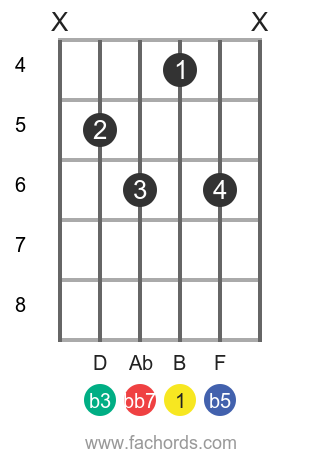
Substituting the VI with #i dim (A7 to C#dim)
Also if we ever have a major VI we can treat it as a dominant and replace it with a #i diminished chord like so.
Cmaj7 | A7 | Dmin7 | G7 becomes Cmaj7 | C#dim | Dmin7 | G7
Example songs
You will often see this I-I#dim change in standards like:
- Let It Snow"
- "I Could Have Danced All Night"
Swapping the V with Vdim (G to G dim)
Sometimes the V chord is simply diminished in the progression which is used in songs like " This Love " (which also uses an iv instead of IV).
G

G dim
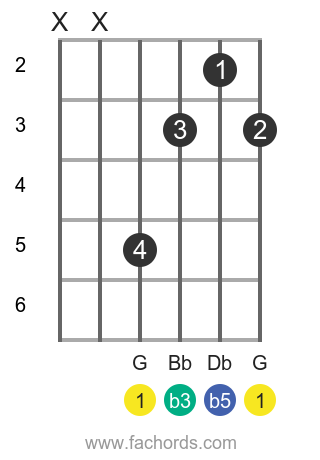
Or we can try replacing the Vdim with a #Vdim :
G

G# dim
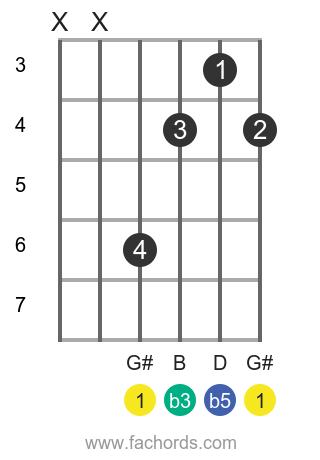
It is very common to hear the #Vdim-I cadence at the end of a jazz standard piece.
You should notice now that a diminished can go on more than just the V and VII.
Example Songs
In the song " Michelle " in the key of F, instead of a Dm the Ddim is used .
In general the diminished VI is a great common turnaround in jazz music.
Using Tritone Substitution (G7 to Db7)
Remember the tritone is the diminished fifth/augmented fourth interval , which spans 6 half-steps.
It divides exactly the octave into 2 equal parts, and it's famous for its dissonant sound.
In fact, it was called the devil's interval .
A tritone substitution occurs whenever a dominant 7th chord is being substituted or replaced by another dominant 7th chord with a root a tritone interval away (basically you shift the chord 6 half-steps up)
For example G7 is replaced by Db7 as G-D is a fifth so G-Db is a diminished fifth.
G7

Db7
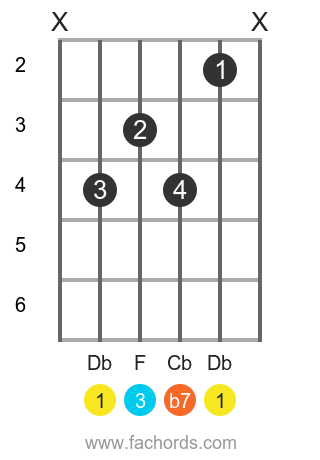
This is very common in jazz but a couple of pop examples are " Girl from Ipanema " and " If I Fell ".
Below is an example of chord progression using this substitution.
Dm7 | G7 | Cmaj7 becomes Dm7 | Db7 | Cmaj7
When to Use Chord Substitution
It isn't necessary to really memorize all of the methods above.
The key stuff to memorize is scale formulas , tone structures , and music keys .
Once you know the basics and how they relate to one another the the substitution will become second hand .
In every substitution above we have used chords with similar notes or raised or lowered notes in the chord.
No matter how complicated the substitution seems, it is always the same simple process.
It's not always easy to find song examples of substitutions, especially as our chords get more complicated in jazz it can be hard to pin them down.
But as you play more tunes you will notice they usually follow the chord progressions and substitutions discussed above.
As you practice make sure you write the chords down and find the structure of the song.
Eventually you will be comfortable writing your own music after having "dissected" many other tunes.
First start with simple substitutions like major/minor changes and simple chord family familiars.
From there try adding a few diminished chords in the progression, chop off notes, add them, invert them; manipulate the notes in any way that sounds good.
With some practice and experimenting you may just turn a common chord progression into a great new song!
To stay updated, subscribe here for free.